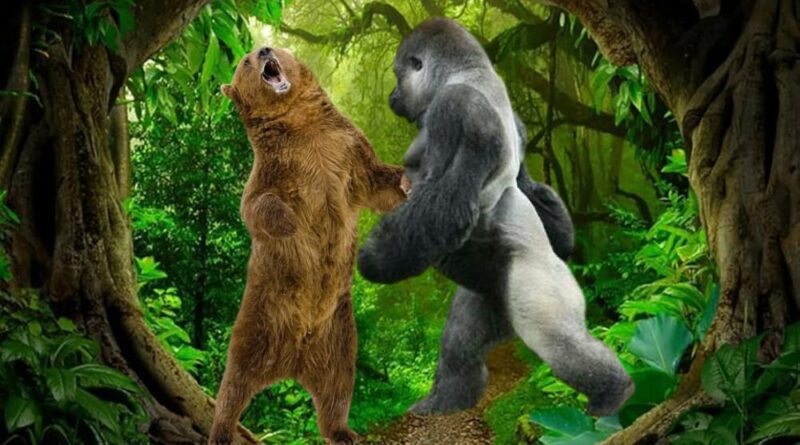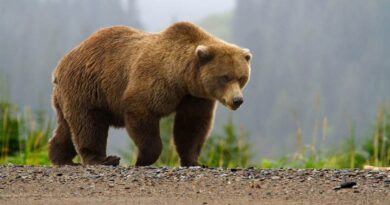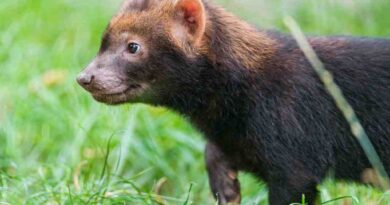Gorilla vs. Bear: Who Would Win?
The thought of a Gorilla and a Grizzly Bear facing off is a fascinating question many animal lovers have pondered, but it’s a duel that few have witnessed—or even imagined. On channels like Nat Geo and Discovery, we often see famous animal fights, yet this contest remains unpopular and unveiled. In theory, these two powerful creatures make an exciting match: each has its own strengths, from the fierce strength of the Grizzly to the intelligence and agility of the Gorilla. This is no ordinary animal fight; it’s a battle that pits might against wit, and despite what we think we know about fights in the wild, the outcome of this duel is not something we’ve truly seen before. The question remains—if they were ever brought together, who wins?
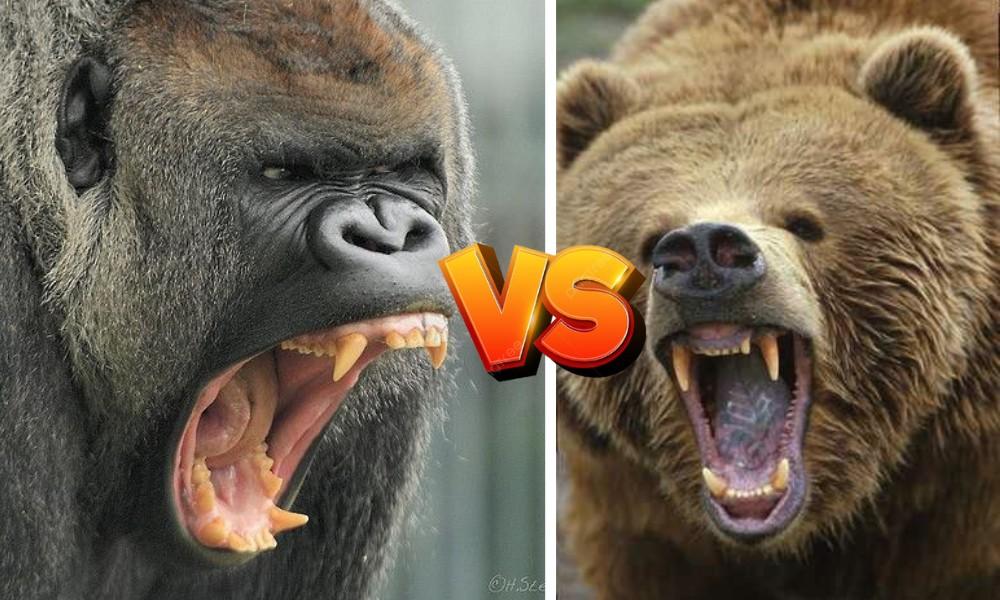
Physical Attributes
-
Size and Weight
- Average size of a gorilla: The Western lowland adult male gorilla is an impressive creature, with an average body length of about 1.7 m (66.9 in.) and a weight close to 169.5 kg (374 lbs.). In the wild, male gorillas generally weigh between 136–227 kg (300–500 lbs.) and stand around 1.4 to 1.8 m (4 ft 7 in to 5 ft 11 in) tall. Their arm span can stretch to an astonishing 2.3–2.6 m (7 ft 7 in to 8 ft 6 in), giving them incredible reach and strength. Adult females are smaller, averaging 1.5 m (59.1 in.) in length and weighing about 71.5 kg (158 lbs.), with wild females typically weighing between 68–113 kg (150–250 lbs.).
-
- Average size of a bear: Brown bears are large and powerful animals, with males usually outweighing females. Their head and body length ranges from 1.4 to 2.8 m (4 ft 7 in to 9 ft 2 in), and their shoulder height can reach 70 to 153 cm (28 to 60 in). Their weight varies widely, from 80 to 600 kg (180 to 1,320 lb), but coastal brown bears, with a diet rich in fish, can get even bigger, sometimes reaching 1,000 pounds by fall. In places like Yellowstone National Park, grizzlies have been recorded weighing up to 900 pounds, showing just how massive these bears can be. With a short tail around 6 to 22 cm (2.4 to 8.7 in), brown bears are built for strength and endurance, making them formidable opponents.
-
Strength and Power
- Gorilla’s strength capabilities: A grown silverback gorilla possesses immense strength, often estimated to be 10 times greater than its total body weight. An adult male can reportedly carry around 885 pounds (approximately 401.5 kg), and some studies suggest that silverback gorillas might even lift up to 4,000 pounds (1,810 kilograms) under ideal conditions. Standing about 5’5 ft on all fours and up to 6’0 ft when upright, these powerful animals are also equipped with a bite force of 1,300 PSI and a punch force between 1,300 and 2,700 pounds, making them a truly formidable force in any fight.
-
- Bear’s strength capabilities: Bears are extremely powerful animals and can easily bend open car doors or pry windshields in their search for food. Known for their ability to routinely roll huge rocks and logs, grizzlies, for example, can lift and even throw an animal weighing up to 1,000 pounds a significant distance. With a bite force measuring around 800 PSI (pounds per square inch), bears are strong enough to crush bones and tear through tough materials. Their sharp claws are a deadly asset, capable of inflicting crippling injuries to nearly any opponent. Black bears are said to be five times stronger than the average human, and their 2.5-inch teeth make them even more fearsome, capable of inflicting fatal injuries with a single swipe.
-
Speed and Agility
- Speed comparison in different terrains: The Silverback Gorilla is surprisingly fast for its size, reaching running speeds of 20–25 mph over short distances. Though its bulk is substantial, the Gorilla remains agile and can maneuver through dense forests with ease, showing great agility as it climbs and swings from trees. On the other hand, Grizzly bears are remarkably quick and count among the fastest large land mammals, with running speeds of 30–35 mph. Grizzlies are not only excellent swimmers but can also navigate rugged terrain effortlessly, making them well-suited for various landscapes.
-
- Agility and maneuverability: Grizzly bears are powerful animals with strong paws and sharp claws that give them an advantage when facing any opponent. Their necks are thicker than a gorilla’s, making it hard for a Gorilla to attempt a choke or snap hold. While a gorilla is highly spry and skilled in quick movement, a grizzly has a bigger size and more raw power, allowing it to counter with devastating bites and claws. The grizzly’s primary advantage lies in its larger frame and weapons like claws and powerful bites, which could finish a weaker opponent. Though gorillas are stronger in upper body strength and capable of quick maneuvers, the grizzly bear’s strong paws and sheer size might give it the upper hand in a direct encounter.
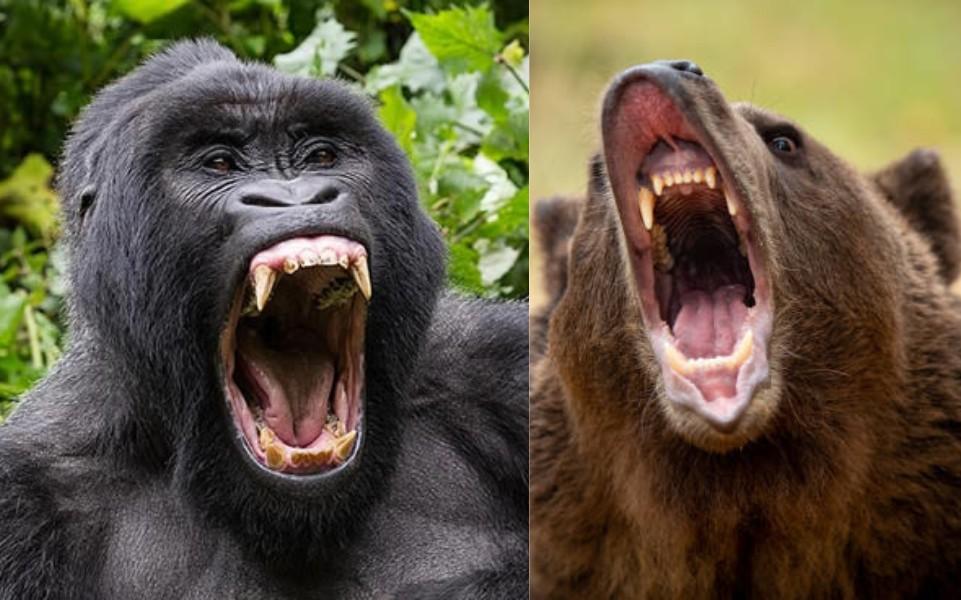
Natural Weapons
-
Teeth and Jaws
- Bite force of a gorilla: A gorilla’s bite is incredibly strong and impressive, especially when we talk about the Silverback. With its large canines, a gorilla can reach a bite force of 1,300 pounds per square inch (PSI). This recorded strength is much stronger than a lion’s bite at about 650 PSI or even a great white shark’s at around 625 PSI. Such power is best understood when you observe these animals’ features while trekking in places like Uganda, Rwanda, or the DR Congo, where gorillas are protected in their natural habitats.
-
- Bite force of a bear: Among bears, the Polar Bear holds the strongest bite force, reaching up to 1200 PSI, while the Grizzly Bear comes in a close second with a bite force of around 1160 PSI. While gorillas are non-carnivores and primarily plant-eaters, they still boast a strong bite force of 1300 PSI, an impressive feat for an animal not evolved as a predator. As of February 15, 2022, these numbers place both bears and gorillas on the list of animals with the most powerful bites in the animal kingdom.
-
Claws vs. Fists
- Gorilla’s use of fists and hand strength: A gorilla’s hand strength is powerful, and unlike many ape species, gorillas have strong, dexterous hands that allow them to manipulate objects with fine movements. Their fists are formidable tools, capable of delivering blows in defense. What’s unique about a gorilla’s hands is the positioning of the thumb opposite the index finger—almost exactly like humans—giving them precise control. This feature lets gorillas work with both hands and mouths to grasp, strike, and handle objects, making them exceptionally skilled in their use of fists and hand strength in the wild.
-
- Bear’s claws and their effectiveness: The claws of a bear are powerful tools that vary across species but are especially notable in polar bears. These claws are not retractable, making them durable and weathered for tasks like digging and manipulating objects. While often blunt from walking on rough terrain, a bear’s claws, when swung with sufficient force, can cause serious damage to opponents. This effectiveness adds to a bear’s ability to defend itself and dominate in a confrontation.
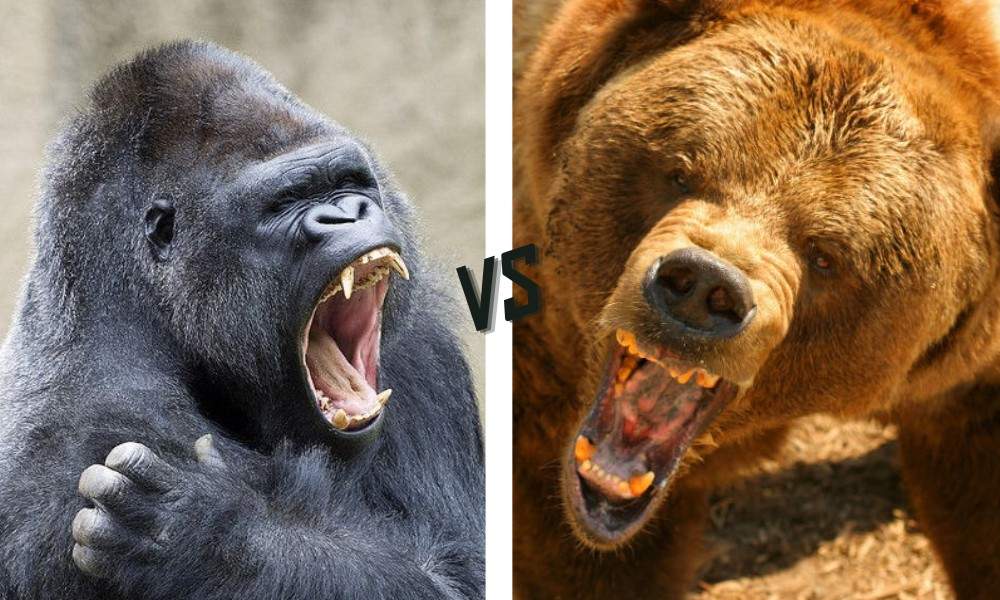
Behavioral Traits
-
Aggressiveness and Temperament
- Natural behavior of gorillas when threatened: Mountain gorillas typically live in groups or troops of about 10 to 30 members, led by a dominant male called the silverback. This position is earned over many years, and the silverback uses powerful displays like charging and chest pounding to intimidate rivals and warn threats away. If a threat is perceived near the group, the silverback often steps forward, demonstrating strength to protect the troop from potential danger.
-
- Natural behavior of bears when threatened: When a bear feels threatened, it may use several intense displays to scare off the danger. It can roar or growl, sometimes even slapping the ground to show strength. Bears often huff or blow air through their nose or mouth and might even snap or pop their teeth to create a sense of unease. Sometimes, a bear may bluff charge, running straight toward the source of the threat, only to veer away at the last moment to intimidate. These behaviors are intended to avoid confrontation while asserting dominance.
-
Fighting Techniques
- How gorillas defend and attack: Mountain gorillas have powerful ways to defend and attack when needed. When facing a threat, they often stand upright to appear huge and taller, which helps scare predators. They also put on displays to show off their strong canine teeth, which are a key defense against opponents. These canines are capable of delivering a bite that can cause deep wounds—and, if serious enough, even death to their attacker. This show of strength helps deter many would-be threats from getting too close.
-
- How bears defend and attack: When bears feel threatened, they often act aggressively to show intent to defend themselves while trying to avoid physical confrontation. Standing on their hind legs makes them appear larger, and they may lay their ears back, snort, and even swat the ground with their powerful paws. Sometimes, they’ll perform a bluff charge to intimidate and test if the threat will back down, hoping to avoid an actual fight. These tactics help bears control the situation without needing to bite or attack directly.
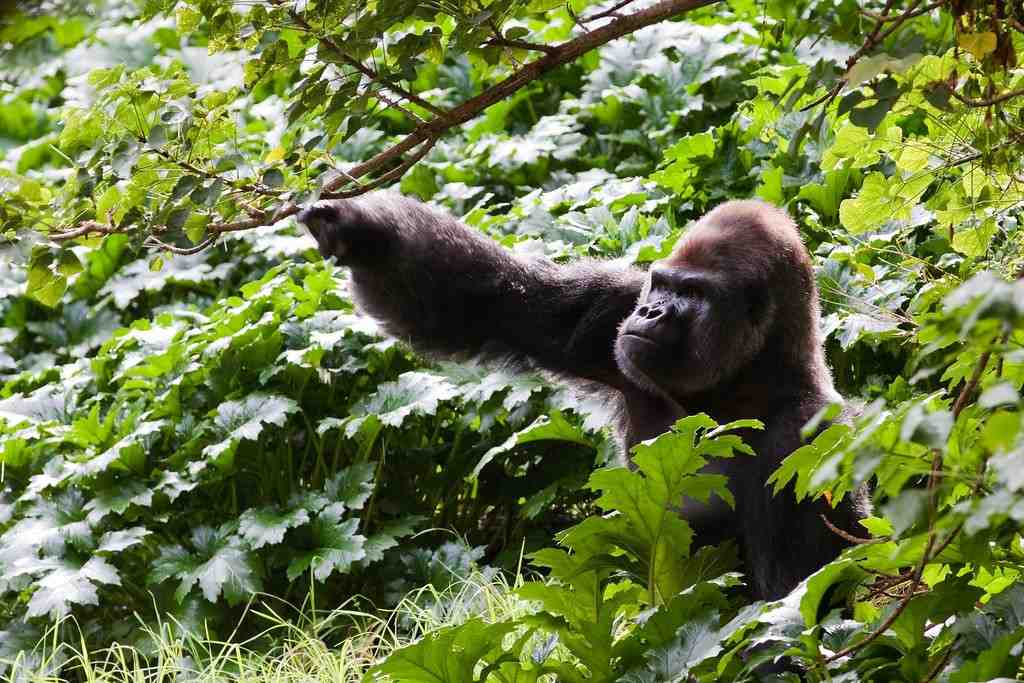
Environment and Habitat
-
Role of Environment in Battle
- How different terrains might influence the outcome: Grizzly bears have a clear advantage in terms of speed and versatility across different terrains. They are remarkably quick and can reach running speeds of 30 to 35 mph, making them some of the fastest large land mammals. They can also navigate rugged terrain and are strong swimmers, allowing them to move with ease across various landscapes. While gorillas can run at speeds of 20 to 25 mph over short distances, their bulk and strength are better suited to dense forests, where their agility as climbers helps them maneuver. However, in open terrain, the grizzly bear would likely outpace the silverback gorilla in the running category.
-
- Advantages/disadvantages for each in forests, mountains, etc.: In forests and mountains, gorillas and black bears play essential roles that impact local biodiversity in unique ways. Gorillas, by naturally spreading seeds in openings of the forest canopy, help plant species grow and thrive, maintaining rich, diverse landscapes. However, gorillas face major threats from habitat loss due to deforestation, mining, and logging, as well as poaching where they are often hunted for meat or caught in snares. Additionally, gorillas are vulnerable to disease, which they can catch from humans and livestock because of their limited immunity. In comparison, black bears benefit their ecosystems by acting as seed dispersers, scavengers, and omnivorous predators that consume plants, berries, and even human trash. They enrich the forest soil by dragging salmon carcasses that add nitrogen and support healthy plant growth. While female gorillas face a challenging pregnancy of nine months with a long period of raising infants over years, bears reproduce differently but still contribute immensely to their ecosystem by feeding on small animals and pet food left out by humans, blending the habits of both scavenger and predator effectively.
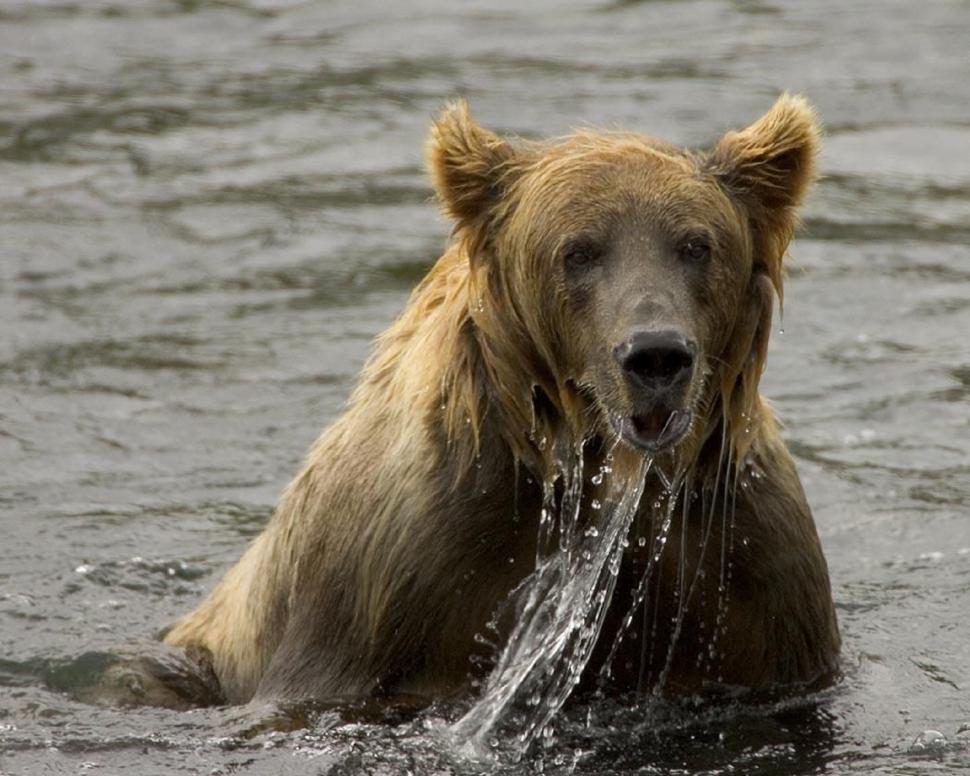
Myth vs. Reality
-
Common Misconceptions
- Popular myths about gorillas: Many people have wrong ideas about gorillas and their behavior. Often seen as scary due to their muscular build and the way they beat their chest, these powerful animals are misunderstood. Unlike common belief, gorillas are not monkeys; they are primates with complex social behaviors and high intelligence. Another myth is that gorillas love to eat bananas, but in reality, their diet is diverse, including leaves, stems, and fruits found in their natural habitat. Gorillas are also not suitable as pets because of their strength, unique social needs, and the challenging environment they require to thrive.
-
- Popular myths about bears: There are many myths about bears that don’t reflect the true nature of these animals. Some people think bears have poor eyesight, but they actually see quite well and use their sharp vision to spot food or threats. While often labeled as pure carnivores, bears, especially brown and grizzly species, are more omnivorous, eating a mix of plants, berries, and fish. Another myth is that they cannot run downhill without stumbling, yet bears are highly agile and can move fast in any direction, even on slopes. People often believe that bears are always attacking, but most prefer to keep away from humans unless provoked.
-
Scientific Perspectives
- Studies and expert opinions on animal combat: Nature often appears brutal, with documentaries focusing on the fierce “red in tooth and claw” reality where animals eat or get eaten. However, many biologists emphasize that animal life is more about balance than endless fighting. Each species behaves according to its unique adaptations for survival, developed through evolution to meet the daily challenges it faces. Though aggression and damage can occur, these interactions aren’t purely selfish behavior; they’re part of an intricate web where animals weigh the costs and benefits of every action. In this balancing act, what may seem like a “fight to the end” is often about survival without unnecessary risk.
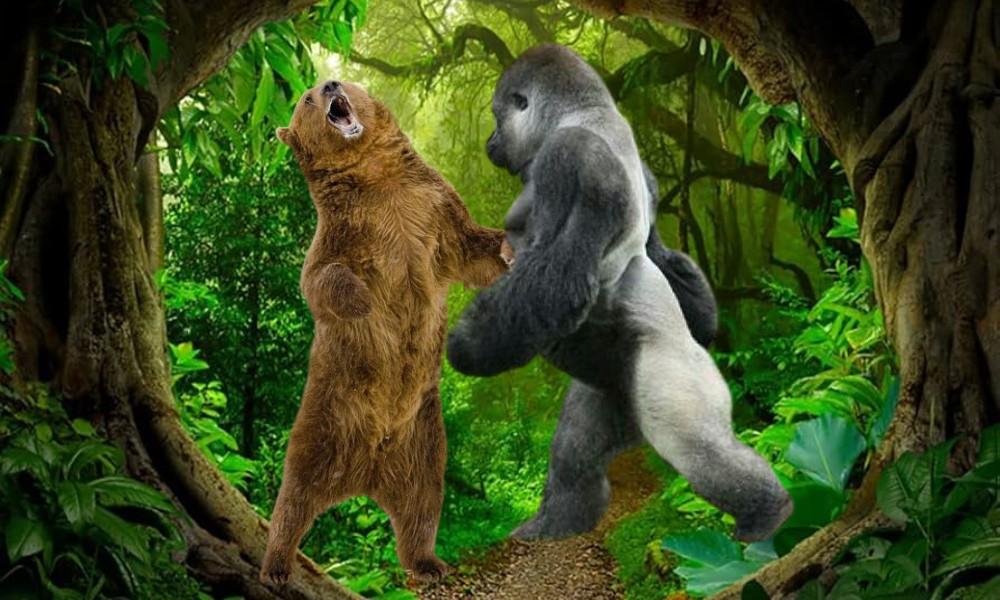
FAQs
Are gorillas stronger than bears?
When comparing gorillas and bears in terms of strength, each has unique advantages. A grizzly bear, for example, can weigh between 800 and 1,100 lbs and is powerful enough to lift or drag heavy objects, while a black bear weighs around 300 to 485 lbs. A mature silverback gorilla, such as an eastern or western male, typically weighs 200 to 220 lbs but has incredible upper body strength that lets it lift several times its own weight. While gorillas have strong necks and can squeeze with impressive force, a bear’s thicker neck and sharp claws and bites give it a clear advantage in a close-range fight. This is why, despite gorillas’ amazing strength, bears have the upper hand in finishing moves with their natural claws and weight.
How do gorillas and bears coexist in the wild?
Though gorillas and bears live in different areas in the wild, their interactions with humans highlight how people can coexist peacefully with these strong animals. For gorillas, humans need to show respect by avoiding direct eye contact and not trying to establish dominance. If a gorilla charges, it’s advised to stay calm, crouch down, and act non-threatening, sometimes pretending to eat vegetation. In bear territory, it’s essential to use bear-proof containers to store food and garbage securely or hang items 10 feet off the ground. While recreating in bear country, it’s wise to travel in groups and make noise to alert any nearby bears. To prevent conflicts with bears, people can use fences to protect crops or avoid leaving berries and other natural attractants that draw bears close to human settlements.
What animals are predators to gorillas and bears?
Leopards and crocodiles are among the few natural predators of gorillas, but their attacks are rare. Typically, only when gorillas venture near rivers might a crocodile attack, given that they rely on stealth and the element of surprise. A grizzly bear, on the other hand, is a different level of opponent due to its size and sheer strength. A grizzly, larger than most other bears, can weigh up to 800 lbs and often averages around 400 lbs. With claws as sharp as dagger-like tools, grizzlies are capable of tearing through flesh and even bones. While gorillas have a build that is incredibly strong, a bear’s bite can be equally effective if it manages to land one, making it a formidable contender.
Can a human intervene in a fight between a gorilla and a bear?
It’s unlikely that any human could intervene in a fight between a gorilla and a bear due to the sheer strength and power of these animals. A silverback gorilla, for example, can lift up to 815 kg—more than the combined weight of 20 adult humans. Although gorillas have impressive defense skills, they lack the thick fur and fat layers that grizzlies possess, which protect them from serious injury. Grizzlies also have claws and teeth suited for intense combat and are taller and heavier, making it impossible for humans, with their thin skin and lack of natural mechanisms for protection, to withstand the extreme “punishment” from either animal.
What role does intelligence play in an animal fight?
Intelligence gives both the silverback gorilla and grizzly bear certain advantages, although in very different ways. A gorilla is one of the most intelligent animals, showing complex behaviors like problem-solving and even tool use in certain situations. Their advanced social intelligence helps them maintain a dominant position within their groups, giving them an edge in strategic thinking and decision-making. Meanwhile, the grizzly bear relies on excellent memory for locating food sources and has strong foraging techniques like digging, fishing, and hunting. This cognitive function is highly developed for navigation and survival, making intelligence a significant factor for both in the wild.
Conclusion
- Sum up key points on strengths and weaknesses: A real-life fight between a gorilla and a bear is highly unlikely since they live in different parts of the world, but the question still sparks endless debate. Each of these animals has unique strengths: a gorilla has the advantage in pound-for-pound strength, lifting power, and agility, while a bear is generally larger and equipped with deadly claws, teeth, and natural predator instincts. Which would win depends on many factors like size, species of the animal, and even the terrain and temperaments during the fight.
- Reflect on the hypothetical nature of such scenarios: A real-life fight between a gorilla and a bear is not only highly unlikely but purely hypothetical, as they live in different parts of the world. Yet, the question sparks endless debate among fans of both animals. Each has unique strengths: the gorilla is pound-for-pound stronger with remarkable lifting power and agility, while the bear is typically larger and more equipped with deadly claws, teeth, and natural predator instincts. The outcome would depend on factors like size, species, and even the terrain and temperaments of the animals in a fight.
Final Suggestions
While we can imagine a thrilling ultimate showdown between a gorilla and a bear, it’s even more rewarding to appreciate their unique strengths and abilities in the natural world. Each is a magnificent creature with impressive size, strength, speed, agility, and a unique blend of intelligence and strategy. For any wildlife enthusiast or anyone intrigued by animal behavior, understanding their defensive and offensive capabilities offers a deep appreciation for their prowess in nature. Both animals are formidable fighters whose power and curiosity give us a glimpse into the thrilling beauty of the natural world.
